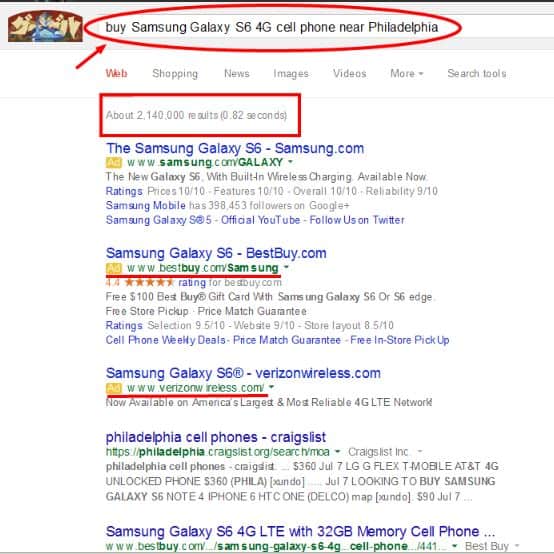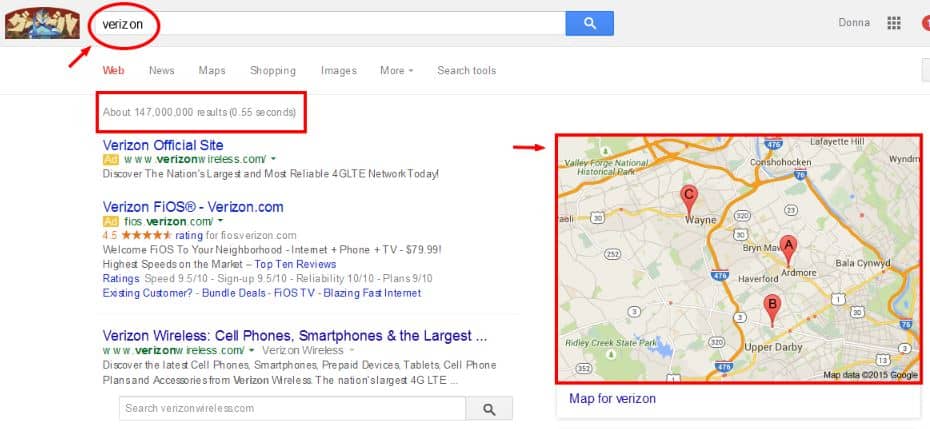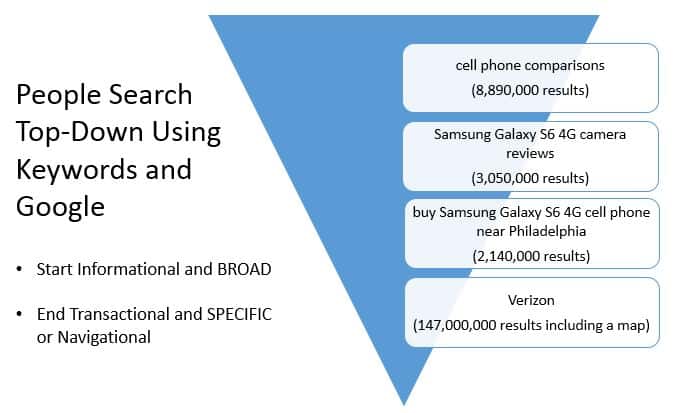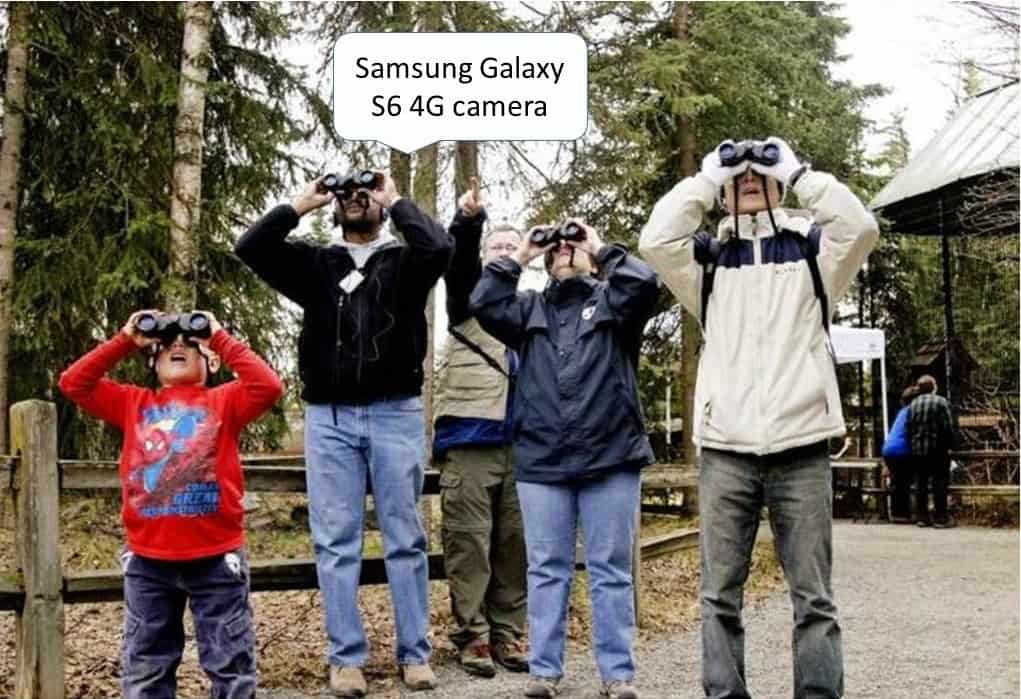Estimated Read Time: 8 Minutes
Last Updated: September 16, 2024
Satisfy More Customers
Let’s start by defining what I mean when I say “satisfy more customers”.
Someone has just landed on your website. They arrived by typing a query into a search engine, probably Google, and clicking a search result that contained a link to your website. If the link to your website was in the top 10 search results, Google probably thought the content at that address would be able to satisfy the information needs of searcher, their “search intent“.
Search Intent
Search intent is what someone plans to do with the information provided in a search result. If someone searches for “Amazon shoes”, for example, search engines have to decide whether the searcher is trying to find shoes from the Amazon, or shoes for sale at Amazon. Google figures that out, in part, by examining the search terms typed into their search engine and past search behavior of the searcher. It decides what to rank where in search results by reviewing the relevance, authority (respected, useful, consistent high-quality content), and trustworthiness of available options.
Your job is to satisfy the user query. Knowing why and how people search is a good starting point.
Why People Search
People search for a reason. They want to:
- navigate to a specific website or web page;
- find information; or
- transact.
The difference between these three types of searches is broad intent:
- The first group knows exactly where they want to go, they just can’t remember how to get there. They type a navigational query into a search engine to find the website or page rather than typing in the long URL into their browser address bar – assuming they even know it. For example, a person might type “Sprint” or “Verizon” instead of www.sprint.com or www.verizonwireless.com. The website they’re looking for usually shows up close to the top. They click on it and they’re satisfied.
- The second group doesn’t have a destination in mind. They want information that will help them answer a question or do something. Informational queries consist of phrases like “cell phone comparisons”, “iPhone vs Samsung”, or “how to take a screenshot using an iPhone”.
- The third group is ready to transact. They know exactly what they want but don’t know where to get it. Transactional queries include specific brand names, product names, or a combination of both. “Samsung Galaxy S6 4G”, “buy Samsung Galaxy S6 4G” and “Samsung Galaxy S6 4Gs for sale in Philadelphia” are all examples of transaction queries. [br]

Photo by Matthew Henry from StockSnap
The vast majority of search queries – 50-80% – are informational in intent. This is one of many reasons why blogging is so popular. Searchers have a lot of questions they want to have answered before making a decision to transact. Creating original, high-quality, detailed, accurate, and helpful content is a way for you to get found on the Internet, and for you to begin to build a relationship with prospective new customers.
“All things being equal people will do business with, and refer business to, those people they know, like, and trust.” The Go-Giver by Bob Burg and John David Mann
So if you know most searcher’s intent is informational, and you know you can build trust by providing high-quality, sought-after information, your goal should be to create the specific content people are looking for, and to ensure it is respected, useful, consistently high-quality. The next section talks about how people search. It will help you understand what I mean when I say “specific”.
How People Search
In 2012, Fleishman-Hillard and Harris Interactive did a study to try to quantify how often different channels were being used to mine for information about companies. They found the Internet “trumps all other sources, including advice from friends and family” and that “eighty-nine percent of consumers surveyed use Internet search engines to make purchasing decisions, punctuating the need for a strong search engine optimization (SEO) strategy.”
The founder of Moz (Rand Fishkin), Eric Enge, Stephan Spencer, and Jessie Stricchiola wrote a well-received book called The Art of SEO back in 2010. It talked about how search engines invest significant resources into understanding how people search so they can produce better – faster, fresher, and more relevant – search results. They observed search as being a multistep process, one that involves persistent and repeated searches over a period of hours or days starting with a general search term (like best mobile phones) and gradually getting more specific as they get closer to their goal.

Moreover, SEO company Moz did a study in 2014 that showed quick conversions shouldn’t be your end goal unless you’re only planning a single sale per customer. Moz found searchers tended to visit their website an average of eight times before deciding to take a free trial (convert). And here’s the interesting part – customers who visited ten times or more before converting turned out to be much more loyal and profitable over the long run. Their loyalty grew in proportion to the number of times they visited the website before conversion.
An Example
Let’s say I’m looking to find information about the latest cell phones. If I’m a typical Internet user, I will start with an informational query and type something like “cell phone comparisons” into my favorite search engine (Google).
Google returned 8.89 million search results for that query. After skimming through comparisons, I decide I’m leaning toward the Samsung Galaxy S6 4G phone, but want to find out more about its camera. I lengthen my informational query so it now becomes “Samsung Galaxy S6 4G camera reviews”.
This time I get about half as many results, roughly 3 million. After reviewing those, I decide I’m ready to buy. I type “buy Samsung Galaxy S6 4G cell phone near Philadelphia” into Google.

I’m starting to catch on now. I realize the more specific the keyword phrases I type into Google, the fewer and better results get returned. This time I was shown just over 2 million results and the top results are very familiar to me, Samsung itself, Best Buy, and Verizon.
I recognize both Best Buy and Verizon. I know I can get the phone either place, their prices are the same or very similar, and the Best Buy website checkout process is lengthy and complicated.
I don’t have a good impression from my past experience with the Best Buy website, so I decide to do a navigational search for “Verizon”.

Google’s top organic search result is for the Verizon Wireless website (www.verizonwireless.com). I’m also shown a map with red push-pins indicating the stores closest to my searching place.
I now have exactly what I need. I can either go online and order directly from Verizon, or I can drive a couple of miles down the road and go to one of their local stores.
People Search Top-Down
The example above illustrates how search is a top-down, multi-step process.
- I started with a short, broad informational query and keyword phrase that returned close to 10 million results.
- I quickly narrowed my options down to something more manageable using longer, more specific, keyword phrases.
- I decided WHAT I wanted to buy, and entered a transactional search (using the words “buy” and “Philadelphia”) to figure out WHERE I could get it.
- Relying on my past experience with one of the options presented in search results, I decided to buy from Verizon. I did a Google Navigational search (using the brand name “Verizon”) and was shown the company’s website and nearby store locations.

I’m ready to transact.
Take-Aways
There are a couple of take-aways reinforced with this example.
- It’s important to know how people are searching for your goods and services. Your website content should use the same language as your searching audience.
- Most people don’t look beyond the first page of search results. They modify their search query instead.
- As queries are modified, new information is learned and absorbed and the searches become more and more specific.
- People are rarely ready to transact on their first visit to a website.
- Your SEO and content marketing strategy should involve creating lots of original, useful, and high-quality content to help people get answers to their questions and differentiate you from the competition.

Aim for the long-haul. Your reputation precedes you and influences searcher behavior. Freely give away the information your audience wants and needs. You will become their trusted, go-to resource, and they, in turn, will become repeat customers who willingly advocate on your behalf and generate more revenue.





Leave A Comment